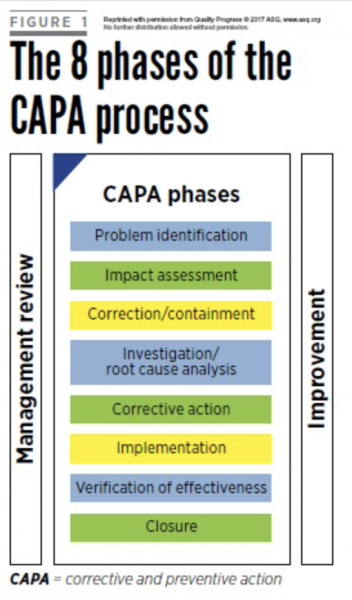
© Ground Picture/Shutterstock.com
Key Points
- Correction action is a means of permanently rectifying an issue.
- There are eight phases to any corrective action plan, with documentation being gathered throughout.
- CAP also allows you to see whether you’re having issues with employee performance.
Corrective action is the process, known as a corrective action plan (CAP), of taking the appropriate steps to identify the root cause of a problem and implementing a solution that corrects the root cause to prevent its recurrence. The aim is to improve the processes in place within an organization so that problems do not reoccur. It is not a temporary correction to a failure that only aims to mitigate damage.
Overview: What Is a Corrective Action?
ISO 9000:2005 guidelines define a correction as the action taken to eliminate a nonconformity, while a corrective action is taken to eliminate the cause of a nonconformity. A related concept is preventative action, which is taken to eliminate the cause of a potential (future) nonconformity. A preventive plan becomes a corrective plan when it is implemented to address a problem that has already occurred.
Corrective and preventative action (CAPA) is a strategy for investigating the root cause of a problem, implementing a solution to prevent its occurrence (preventative) or recurrence (corrective), and documenting the issue and its solution. A CAPA program can be implemented complementary to Lean Six Sigma to promote continuous and effective improvement of a company’s processes.
The 8 phases of the CAPA process are detailed in the figure below.

Why It Matters
Temporary fixes aren’t going to be tenable in the long term for any organization. As such, it is important to remember that lasting fixes are going to be your best course of action. Further, it allows you to alter processes and production lines to better suit an organization’s needs.
3 Benefits of Corrective Actions
Action plans provide a coherent strategy to implement change within an organization and are recognized as a key tool for process improvement. Organizations can benefit from a formal problem-solving process in a few following ways.
1. Creates a Timeline for Completion
Problems cannot be left uncorrected due to the waste it creates and potential hazards. The process for implementing corrective action should also be efficient and not tie up resources unnecessarily.
2. Clear Instructions for Implementing Change
With a written strategy, teams can easily monitor, manage, develop, improve, and evolve solutions with confidence. Furthermore, the process of developing a formal CAP provides a record of decisions made and the rationale behind them. This is useful for addressing any questions that arise during implementation and can guide the evaluation process.
3. Address Employee Performance Issues
A CAP can be formulated to address employee performance issues and provide a clear strategy for the employee to demonstrate their willingness to improve. Setting specific, measurable, achievable, relevant, and timely (SMART) goals encourages action and transparently facilitates evaluation.
Why Are Corrective Actions Important to Understand?
Addressing the root cause of problems provides a long-term solution and prevents issues from reoccurring. Corrective actions are an important strategy for increasing the efficiency of any organization for several reasons.
1. Effect Change to Solve Systemic Issues
Issues that reoccur can be easily overlooked as part of the process. Implementing a formal process for change can help identify issues deeply ingrained in a process. Addressing such issues improves the efficiency of an organization’s processes and promotes a culture of continuous improvement.
2. Provide Documentation of the Process
Using a formal corrective process for addressing problems provides a documented and transparent account of the steps taken to identify the root cause and address an issue. This is essential for issues of regulatory compliance that require extensive documentation. Documentation also assists during the evaluation of the action taken to ensure the cause of the issue was addressed and that it will not reoccur.
3. Provides a Basis for Future Developments
Change is the driver of innovation. Using a formal process for corrective action creates a forum for discussing business operations and voicing employee ideas. Often the burden of daily tasks discourages employees from taking on abstract issues that are not part of the usual workload.
An Industry Example of Corrective Actions
A medical device provides lab-cultured bone grafts for medical implementation. A batch does not promote sufficient calcification of the biodegradable scaffold. The defective grafts are visually marked to ensure they are not passed on to the next manufacturing step.
After performing a root cause analysis, the issue is found to be contamination of the culture medium due to a shortage in the autoclave.
Using a fishbone diagram, they identify variables that could have led to the short and a process map to test each variable’s probability. It was discovered that the issue was the melting of insulation around a live wire due to a faulty thermal regulator. It was also discovered that the power conditioner was not rated to the required specification of the autoclave, although this was not the cause of the issue the power conditioner was replaced to avoid future complications.
The thermal regulator and wire were replaced, and a procedure for regular equipment maintenance was implemented. An effectiveness check a month later demonstrated the autoclave, power conditioner, and thermal regulator were all working according to specifications.
4 Best Practices to Implement Corrective Action

There are several best practices to ensure a successful implementation of a formal corrective process.
1. Define the Problem
This starts with a thorough understanding of the root of the problem. Creative thinking about the potential circumstances leading up to the issue is helpful. Think through these scenarios, identify the commonalities among them, and choose the most likely scenario.
2. Identify the Proper Solution
One of the most effective methods for streamlining the problem-solving approach of an organization is to first determine if an issue warrants a formal investigation. Some surface-level problems or time-sensitive issues simply require a solution possibly because their recurrence is unlikely, unavoidable, or inconsequential.
ISO 9001:2015 has added instructions for terminating a formal action plan if the problem can be solved without one.
3. Thoroughly Document the Planning Process
Documenting important information provides a reference that can be used for reflecting on the issue and the process to solve it.
4. Conduct Training
To ensure the goals of corrective plans will initiate lasting change in the organization, hold training on how to implement the plan.
Other Useful Tools and Concepts
Looking for some other ways to aid your production? One of the fastest ways you can tell if something is awry is by the use of radar charts. These handy charts take a closer look at two or more data sets and allow you to see outliers at a glance.
Further, you might need to understand the ins and outs of a cause-and-effect diagram. This is a useful method of visualization of the potential causes and subsequent consequences of parts of your processes.
Final Thoughts
Corrective actions provide a step-by-step approach to solving issues and nonconformances within an organization. In conjunction with an effective root cause analysis, a CAP will address the cause of a problem and prevent it from recurring.
The process of developing a CAP provides a detailed account of the steps involved in addressing the issue and the strategy for solving it. Following the implementation of an action plan, an effectiveness check should be performed to ensure the cause of the issue was addressed and the solution promoted lasting change that will prevent the problem from reoccurring.
The image featured at the top of this post is ©Ground Picture/Shutterstock.com.